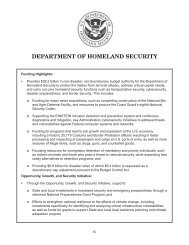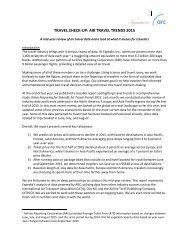A-HRC-13-42
Create successful ePaper yourself
Turn your PDF publications into a flip-book with our unique Google optimized e-Paper software.
A/<strong>HRC</strong>/<strong>13</strong>/<strong>42</strong><br />
page <strong>42</strong><br />
94. Ever since, the Commission continuously called upon its special rapporteurs and working<br />
groups to give special attention to questions relating to the effective protection of human rights<br />
in the administration of justice, in particular with regard to unacknowledged detention of<br />
persons, and to provide, wherever appropriate, specific recommendation in this regard, including<br />
proposals for possible concrete measures under advisory services programmes. 155<br />
95. In 1988, in its resolution 43/173, the General Assembly adopted the Body of Principles for<br />
the Protection of All Persons under Any Form of Detention or Imprisonment. This was the result<br />
of a long-standing process of ascertaining detainees’ rights that had begun under the<br />
Subcommission on Prevention of Discrimination and Protection of Minorities. 156 This instrument<br />
provides for the application of a set of safeguards while in detention, compliance with which in<br />
principle would avoid or substantially decrease the likelihood of threat to life and limb of<br />
detainees. 157 The adoption of the document served as an incentive for the elaboration of<br />
complementary regional instruments, such as the Guidelines and Measures for the Prohibition<br />
and Prevention of Torture, Cruel, Inhuman or Degrading Treatment or Punishment in Africa, 158<br />
adopted by the African Commission on Human and Peoples’ Rights in its resolution 61 (XXXII)<br />
02 (2002), and the Principles and Best Practices on the Protection of Persons Deprived of Liberty<br />
in the Americas, 159 of the Inter-American Commission on Human Rights.<br />
96. Other instances have contributed to outlawing practices of secret detention. As early as<br />
1978, the Human Rights Committee received the first communication under the Optional<br />
Protocol relating to a disappearance and secret detention case in Uruguay. The case concerned a<br />
certain Mr. Bleier, suspected of being connected with the subversive activities of the banned<br />
Communist Party, who had been arrested by that country’s authorities without a court order in<br />
October 1975 and was being held incommunicado at an unknown place of detention. 160 The<br />
155<br />
See for example Commission resolution 1992/31 on human rights in the administration of<br />
justice. See also the report of the Special Rapporteur on torture (E/CN.4/1993/26).<br />
156 Since 1973, the Subcommission had an item on its agenda entitled “Question of the human<br />
rights of persons subjected to any form of detention or imprisonment”. See<br />
E/CN.4/Sub.2/SR.677, pp. 123-129. See generally Kathryn Jean Burke, “New United Nations<br />
procedure to protect prisoners and other detainees” California Law Review, vol. 64, No. 1<br />
(January 1976), p. 205; and Daniel Prémont, “United Nations procedures for the protection of all<br />
persons subjected to any form of detention or imprisonment”, Santa Clara Law Review, vol. 20,<br />
No. 3 (1980), p. 603.<br />
157<br />
Nigel Rodley and Matt Pollard, The Treatment of Prisoners under International Law, Third<br />
ed., Oxford University Press, 2009, p. 451.<br />
158<br />
Also known as Robben Island Guidelines.<br />
159<br />
OEA/Ser/L/V/II.<strong>13</strong>1, doc. 26 (March 2008).<br />
160<br />
Bleier v. Uruguay, communication No. 30/1978, final views of 21 July 1983.
















